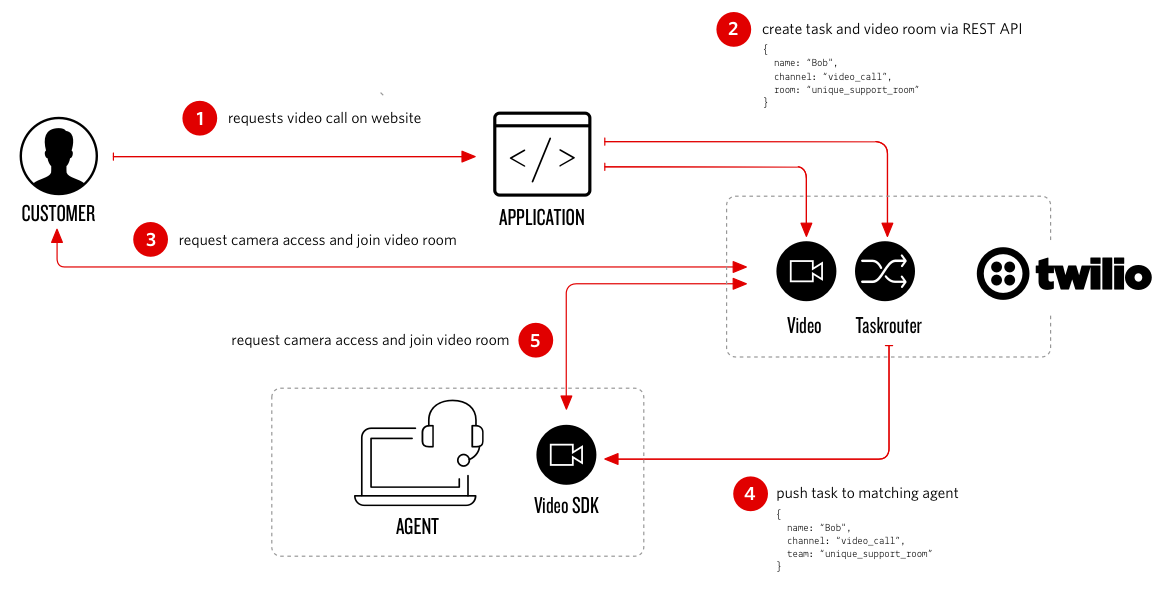Essence of a modern contact center is to serve customers on multiple channels (voice, web chat, video, email, social media, etc.), allow them to move seamlessly across channels and most importantly maintain context of the conversations.
The Twilio Contact Center demo is reference architecture for building a modern contact center. The focus of the demo is to show how to build a Twilio platform based contact center and the various backend and frontend components needed.
Note: We have done the basic work from an UX perspective and lot of opportunities remains to improve on it. Application security implementation is minimal as well in the demo.
This application is provided as-is. Twilio does not officially support it.
- Twilio Account
- Twilio Phone Numbers
- Twilio Programmable Voice (PSTN, Twilio WebRTC Client)
- Twilio Programmable Chat
- Twilio Programmable SMS
- Twilio Programmable Video
- Twilio TaskRouter
- Twilio REST APIs
Customer fills out online call request -> Form submitted to server -> Task on TaskRouter created -> Find available and matching agent -> Agent accepts reservation and dials customer out (PSTN) -> Connect customer to agent (WebRTC)
Customer calls Twilio phone number -> Twilio requests webhook -> Server generates TwiML for IVR -> Caller selects IVR option -> Task on TaskRouter created -> Find available and matching agent -> Agent accepts reservation -> Connect customer to agent (WebRTC)
Customer fills out online web chat request form -> Form submitted to server -> Task on TaskRouter created -> Find available and matching agent -> Agent accepts reservation -> Start chat between customer and agent
Customer fills out video call request form -> Form submitted to server -> Task on TaskRouter and video room created -> Find available and matching agent -> Agent accepts reservation -> Agent joins video room
Real-time display of operational contact center metrics (for example: average call handle time, agent productivity, call metrics, TaskRouter stats, and more etc.)
- Basic of Twilio platform - Twilio <Skills>, an elearning platform that provides a guided path for getting started with Twilio.
- Twilio TaskRouter
- Twilio Client
- Twilio Programmable Chat
- Twilio Programmable Video
- Working knowledge of Angular.js, Bootstrap and Node.js
Before you start the install, you’ll need the following variables from the Twilio Account Portal. If you haven't used Twilio before, welcome! You'll need to Sign up for a Twilio account.
We recommend you create a separate sub-account within Twilio and install this app using that sub-accoount credentials.
Note: It is recommended that you have an upgraded Twilio account to fully experience this demo.
- For Account SID and Auth Token please click here: https://www.twilio.com/console
- Buy a phone number or use an existing one (the application will configure the number for you later)
- Create a new Twilio TaskRouter Workspace
- For creating a new Chat Services or re-using an existing one, click here: https://www.twilio.com/console/chat/services
- For creating a new Video Configuration Profile or re-using an existing one, click here: https://www.twilio.com/console/video/profiles
- For Twilio API Key SID and Twilio API Key Secret, click here: https://www.twilio.com/console/dev-tools/api-keys
This will install the application and all the dependencies on Heroku (login required) for you. As part of the installation, the Heroku app will walk you through configuration of environment variables. Please click on the following button to deploy the application.
After the installation has completed please open https://<your_application_name>.herokuapp.com/setup and configure the application. The demo overview will be accessible at https://<your_application_name>.herokuapp.com.
Fork and clone the repository. Then, install dependencies with
npm install
In order to run the demo you will need to set the following environment variables:
TWILIO_ACCOUNT_SIDTWILIO_AUTH_TOKENTWILIO_WORKSPACE_SID
For web chat you need to set Twilio Programmable Chat environment variables:
TWILIO_CHAT_SERVICE_SIDTWILIO_API_KEY_SIDTWILIO_API_KEY_SECRET
For video calls you need to set Twilio Video Configuration Profile variable:
TWILIO_VIDEO_CONFIGURATION_SID
Start the application
node app.js
Before you can use the demo please open http://<your_application_name>/setup and configure the application. The demo overview will be accessible at http://<your_application_name>. Please note, if process.env.PORT is not set the applications runs on port 5000.
Note: On Google Chrome a secure HTTPS connection is required to do phone calls via WebRTC. Use a tunnel that supports HTTPS such as ngrok, which can forward the traffic to your webserver.
Contributions are welcome and generally accepted. For not trivial amendments it is a good idea to submit an issue explaining the proposed changes before a PR. This allows the maintainers to give guidance and avoid you doing duplicated work.
Your changes must adhere a common project code style.
# please run this before "git commit"
npm run lint
# try automatic fix
./node_modules/.bin/eslint controllers --fix
./node_modules/.bin/eslint public --fix
To make life easier for other contributors and reviewer please rebase your commit in the same PR
git rebase -i HEAD^^^^^^
# then squash or fixup your shards
# and force push into your fork
git push origin [YOUR BRANCH] -f
MIT



